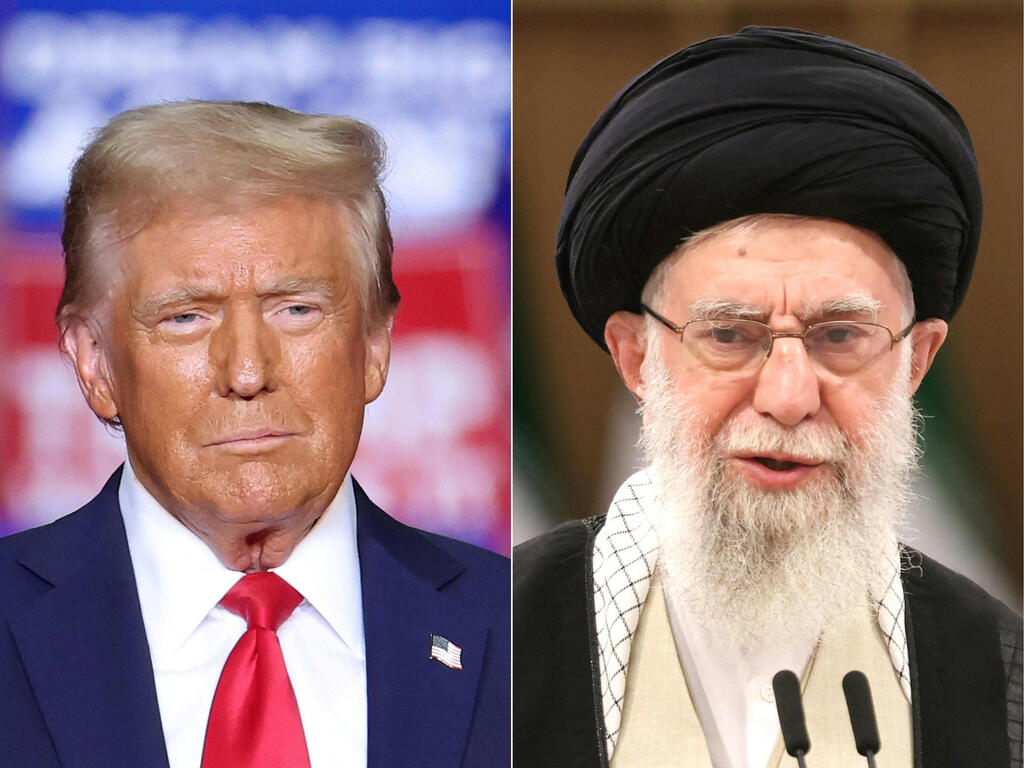The U.S. Air Force’s strike on Iran overnight marks a historic turning point in the nearly four-decade-long struggle to curb Tehran’s nuclear ambitions. For the first time, American forces targeted Iran’s three most critical nuclear sites — most notably the underground enrichment facility at Fordow, long considered the “jewel in the crown.”
The operation also expanded to a deep strike on the vast Natanz enrichment complex and a hit on Isfahan, likely aimed at destroying the highly enriched uranium stockpile that the mullah regime had preserved as a key lever for a potential breakout toward nuclear weaponization.
1 View gallery


US President Donald Trump, Iranian Supreme Leader Ali Khamenei
(Photo: CHARLY TRIBALLEAU and ATTA KENARE / AFP)
The powerful and unprecedented airstrike — whose operational methods and characteristics warrant deeper discussion — had been looming in the skies for days. Much like other major American force projection during the Trump era, the path to attack was deliberate, phased and strategically framed. It was no coincidence that, in his historic address from the White House overnight, the president invoked the name of Qasem Soleimani — the notorious Quds Force commander — whose assassination he ordered in January 2020, defying the recommendations of much of the U.S. security and intelligence establishment.
Much like the targeted elimination of Soleimani, overnight Sunday’s U.S. strike was executed with precision and in clear strategic context—accompanied by a carefully constructed narrative across key communication channels. The orchestration of this messaging, aligning military action with diplomatic rationale, is likely to become a case study in future schools of diplomacy and strategic leadership.
Since the launch of Operation Rising Lion, U.S. President Donald Trump has consistently reiterated the core justifications that would ultimately underpin the decision to strike Iran.
Among the key factors—alongside expressions of admiration for the IDF and a desire to share in a moment of historic triumph—is the unmatched military power of the U.S. Armed Forces. This includes a unique operational capability to strike fortified underground sites like Fordow, which demand a superpower-level conventional response.
"It’s no coincidence that two months earlier, Trump appointed General Dan Caine—a seasoned F-16 pilot—as chairman of the Joint Chiefs of Staff. The move reflected both a desire to embed a more offensive posture within the armed forces and a strategic preference for air power as a tool of decisive, limited engagement over drawn-out, resource-draining conflicts."
Additional drivers include Tehran’s continued refusal to engage in swift and meaningful negotiations with Washington—negotiations that would require a fundamental shift from the nuclear status quo that Supreme Leader Ali Khamenei has entrenched over the past two decades.
Contributing as well are the anticipated collapse of Iranian Foreign Minister Abbas Araghchi’s recent diplomatic efforts with European counterparts in Geneva, and the mounting alarm expressed by the IAEA Board of Governors over Iran’s escalating nuclear activity.
Get the Ynetnews app on your smartphone: Google Play: https://bit.ly/4eJ37pE | Apple App Store: https://bit.ly/3ZL7iNv
On the military front, President Trump carefully shaped the narrative for the strike by grounding it in core U.S. military doctrines. In doing so, he demonstrated a form of leadership that balanced two distinct qualities: on one hand, a resolute independence in decision-making that stood apart from the long-standing influence of the defense and intelligence establishment—a shift from the pattern of past presidents who, even unintentionally, were often bound by institutional caution. On the other hand, he showed deep respect for the military command structure and its operational considerations, ensuring that the groundwork for a successful strike on Iran's nuclear facilities was laid according to professional military standards.
 Avi Kalo Photo: Aloni Mor
Avi Kalo Photo: Aloni MorIt’s no coincidence that two months earlier, Trump appointed General Dan Caine—a seasoned F-16 pilot—as chairman of the Joint Chiefs of Staff. The move reflected both a desire to embed a more offensive posture within the armed forces and a strategic preference for air power as a tool of decisive, limited engagement over drawn-out, resource-draining conflicts. But the war, in the words of the most important military theorist in history, Clausewitz, is a realm of uncertainty.
"Through this unprecedented operation, President Trump has arguably made the world a slightly safer place. Diplomacy must now take the lead in cementing and building upon this achievement."
And now, alongside the inherent risks of drawing the U.S into a broader conflict, what is required is a political wisdom and leadership that is bold yet measured—resolute, cautious and deeply responsible. The goal is to prevent Iran from initiating a prolonged war of attrition aimed at exacting a toll and reestablishing deterrence; and second, to craft a stable, long-term endgame to this military campaign—one that will secure a broad and lasting security buffer, and establish a credible and durable deterrent against any future Iranian nuclear ambitions.
At first glance, it appears that a historic moment has indeed arrived — a decisive turning point in Iran’s nuclear trajectory. The joint Israeli American strike on Iran’s nuclear facilities marks a critical juncture, offering the international community — and particularly the UNSC (Security Council) — a rare opportunity to recalibrate the global arms-control architecture. This isn’t mere rhetoric: through this unprecedented operation, President Trump has arguably made the world a slightly safer place.
Diplomacy must now take the lead in cementing and building upon this achievement.


